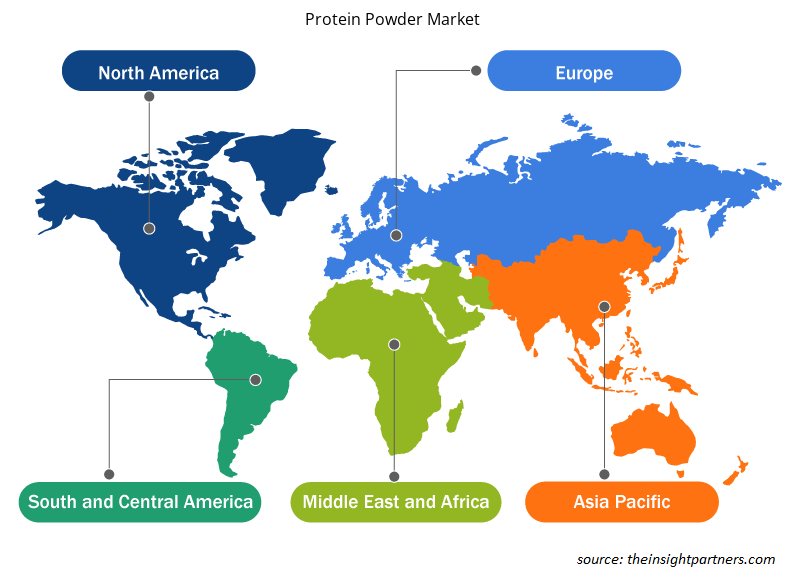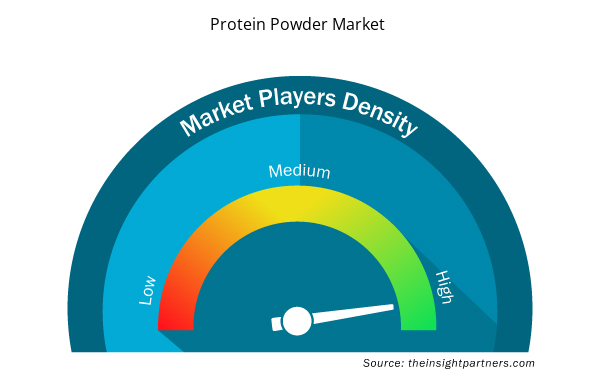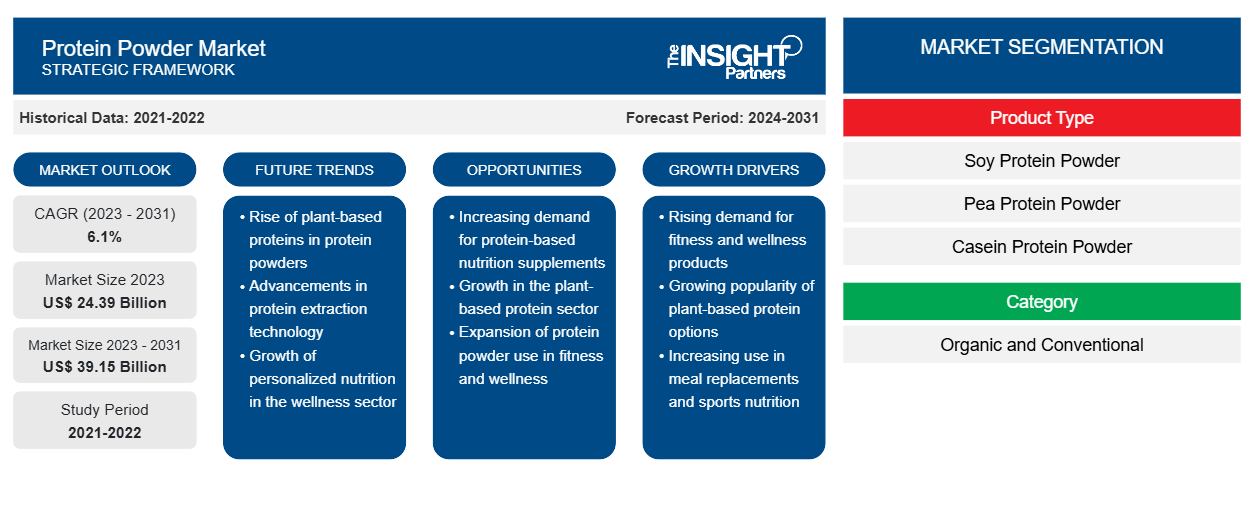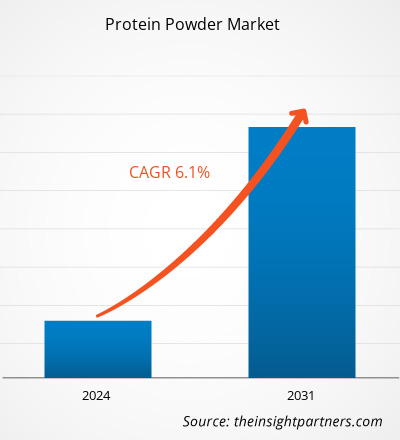Se proyecta que el tamaño del mercado de proteínas en polvo alcance los 39.150 millones de dólares estadounidenses en 2031, frente a los 24.390 millones de dólares estadounidenses en 2023. Se espera que el mercado registre una CAGR del 6,1 % durante el período 2023-2031. Es probable que la creciente demanda de proteínas en polvo de origen vegetal y una mayor concienciación sobre la salud sigan siendo tendencias clave en el mercado.
Análisis del mercado de proteína en polvo
Varios factores clave pueden atribuirse a la creciente demanda de proteína en polvo a nivel mundial. En primer lugar, los beneficios de consumir proteína en polvo han aumentado la conciencia sobre la importancia de la proteína en la dieta. La proteína está compuesta de aminoácidos esenciales, que son útiles para la recuperación y el crecimiento muscular, lo que la hace muy popular entre los atletas, culturistas y entusiastas del fitness. A medida que las personas apuntan a lograr sus objetivos de fitness , a menudo toman proteína en polvo para satisfacer convenientemente sus necesidades diarias de proteína. En segundo lugar, ha habido un crecimiento significativo en la demanda de alternativas de proteína de origen vegetal, lo que ha impulsado aún más la demanda de proteína en polvo. Muchas personas están adoptando estilos de vida basados en plantas o veganos, que no se satisfacen con las fuentes de proteína convencionales. Como resultado, los polvos de proteína de origen vegetal, generalmente derivados de guisantes, arroz y cáñamo, han ganado una popularidad significativa entre la población. Este cambio hacia las opciones de origen vegetal ha ampliado las oportunidades para que el mercado de proteína en polvo atienda a una base de consumidores más amplia y diversa.
Descripción general del mercado de proteína en polvo
El mercado de proteínas en polvo ha estado creciendo significativamente durante el período de pronóstico. América del Norte ha surgido como un importante contribuyente a este crecimiento, debido al creciente número de entusiastas del fitness en la región. Además, la demanda de proteínas de origen vegetal de fuentes como microalgas y lenteja de agua ha aumentado drásticamente, al tiempo que se busca un empaque transparente que enumere claramente todos los ingredientes y sus fuentes. Esta tendencia significa un cambio hacia productos más sostenibles y naturales, impulsado por las preferencias de los consumidores por la transparencia y los ingredientes reconocibles. Presenta oportunidades para que las empresas innoven en productos de proteínas de origen vegetal y empaques para satisfacer estas demandas cambiantes de los consumidores.
Personalice este informe según sus necesidades
Obtendrá personalización en cualquier informe, sin cargo, incluidas partes de este informe o análisis a nivel de país, paquete de datos de Excel, así como también grandes ofertas y descuentos para empresas emergentes y universidades.
- Obtenga las principales tendencias clave del mercado de este informe.Esta muestra GRATUITA incluirá análisis de datos, desde tendencias del mercado hasta estimaciones y pronósticos.
Perspectivas regionales del mercado de proteína en polvo
Los analistas de Insight Partners explicaron en detalle las tendencias y los factores regionales que influyen en el mercado de proteínas en polvo durante el período de pronóstico. Esta sección también analiza los segmentos y la geografía del mercado de proteínas en polvo en América del Norte, Europa, Asia Pacífico, Medio Oriente y África, y América del Sur y Central.

- Obtenga datos regionales específicos para el mercado de proteína en polvo
Alcance del informe de mercado de proteína en polvo
| Atributo del informe | Detalles |
|---|---|
| Tamaño del mercado en 2023 | US$ 24,39 mil millones |
| Tamaño del mercado en 2031 | US$ 39,15 mil millones |
| CAGR global (2023 - 2031) | 6,1% |
| Datos históricos | 2021-2022 |
| Período de pronóstico | 2024-2031 |
| Segmentos cubiertos | Por tipo de producto
|
| Regiones y países cubiertos | América del norte
|
| Líderes del mercado y perfiles de empresas clave |
|
Densidad de actores del mercado: comprensión de su impacto en la dinámica empresarial
El mercado de las proteínas en polvo está creciendo rápidamente, impulsado por la creciente demanda de los usuarios finales debido a factores como la evolución de las preferencias de los consumidores, los avances tecnológicos y una mayor conciencia de los beneficios del producto. A medida que aumenta la demanda, las empresas amplían sus ofertas, innovan para satisfacer las necesidades de los consumidores y aprovechan las tendencias emergentes, lo que impulsa aún más el crecimiento del mercado.
La densidad de actores del mercado se refiere a la distribución de las empresas o firmas que operan dentro de un mercado o industria en particular. Indica cuántos competidores (actores del mercado) están presentes en un espacio de mercado determinado en relación con su tamaño o valor total de mercado.
Las principales empresas que operan en el mercado de proteína en polvo son:
- Nutrición para el rendimiento Glanbia
- Ciencias de la Salud Iovate Internacional Inc.
- Suplementos y nutrición de bioingeniería Inc.
- Nutrición Dymatize
- El grupo de la cabaña
- Naturaleza
Descargo de responsabilidad : Las empresas enumeradas anteriormente no están clasificadas en ningún orden particular.

- Obtenga una descripción general de los principales actores clave del mercado de proteína en polvo
- Análisis histórico (2 años), año base, pronóstico (7 años) con CAGR
- Análisis PEST y FODA
- Tamaño del mercado Valor/volumen: global, regional, nacional
- Industria y panorama competitivo
- Conjunto de datos de Excel



Report Coverage
Revenue forecast, Company Analysis, Industry landscape, Growth factors, and Trends

Segment Covered
This text is related
to segments covered.

Regional Scope
North America, Europe, Asia Pacific, Middle East & Africa, South & Central America

Country Scope
This text is related
to country scope.
Preguntas frecuentes
The global protein powder market is estimated to register a CAGR of 6.1 % during the forecast period 2023–2031.
The driving factors impacting the protein powder market are increasing health awareness, and growing fitness industry.
The future trend of the protein powder market is the growing demand for plant protein in the industry.
Glanbia Performance Nutrition; Iovate Health Sciences International Inc.; Bio-Engineered Supplements and Nutrition Inc.; Dymatize Nutrition; The Hut Group; Nature’s Best; Quest Nutrition; Nestle Health Science; Danone; and Orgain.
The report can be delivered in PDF/PPT format; we can also share excel dataset based on the request.
Some of the customization options available based on the request are additional 3–5 company profiles and country-specific analysis of 3–5 countries of your choice. Customizations are to be requested/discussed before making final order confirmation, as our team would review the same and check the feasibility.
Trends and growth analysis reports related to Food and Beverages : READ MORE..
1.Glanbia Plc
2.MusclePharm
3.Abbott
4.CytoSport Inc
5.QuestNutrition LLC
6.Iovate Health Sciences International Inc
7.The Bountiful Company
8.AMCO Proteins
9.Now Foods
10.Transparent Labs
The Insight Partners performs research in 4 major stages: Data Collection & Secondary Research, Primary Research, Data Analysis and Data Triangulation & Final Review.
- Data Collection and Secondary Research:
As a market research and consulting firm operating from a decade, we have published and advised several client across the globe. First step for any study will start with an assessment of currently available data and insights from existing reports. Further, historical and current market information is collected from Investor Presentations, Annual Reports, SEC Filings, etc., and other information related to company’s performance and market positioning are gathered from Paid Databases (Factiva, Hoovers, and Reuters) and various other publications available in public domain.
Several associations trade associates, technical forums, institutes, societies and organization are accessed to gain technical as well as market related insights through their publications such as research papers, blogs and press releases related to the studies are referred to get cues about the market. Further, white papers, journals, magazines, and other news articles published in last 3 years are scrutinized and analyzed to understand the current market trends.
- Primary Research:
The primarily interview analysis comprise of data obtained from industry participants interview and answers to survey questions gathered by in-house primary team.
For primary research, interviews are conducted with industry experts/CEOs/Marketing Managers/VPs/Subject Matter Experts from both demand and supply side to get a 360-degree view of the market. The primary team conducts several interviews based on the complexity of the markets to understand the various market trends and dynamics which makes research more credible and precise.
A typical research interview fulfils the following functions:
- Provides first-hand information on the market size, market trends, growth trends, competitive landscape, and outlook
- Validates and strengthens in-house secondary research findings
- Develops the analysis team’s expertise and market understanding
Primary research involves email interactions and telephone interviews for each market, category, segment, and sub-segment across geographies. The participants who typically take part in such a process include, but are not limited to:
- Industry participants: VPs, business development managers, market intelligence managers and national sales managers
- Outside experts: Valuation experts, research analysts and key opinion leaders specializing in the electronics and semiconductor industry.
Below is the breakup of our primary respondents by company, designation, and region:

Once we receive the confirmation from primary research sources or primary respondents, we finalize the base year market estimation and forecast the data as per the macroeconomic and microeconomic factors assessed during data collection.
- Data Analysis:
Once data is validated through both secondary as well as primary respondents, we finalize the market estimations by hypothesis formulation and factor analysis at regional and country level.
- Macro-Economic Factor Analysis:
We analyse macroeconomic indicators such the gross domestic product (GDP), increase in the demand for goods and services across industries, technological advancement, regional economic growth, governmental policies, the influence of COVID-19, PEST analysis, and other aspects. This analysis aids in setting benchmarks for various nations/regions and approximating market splits. Additionally, the general trend of the aforementioned components aid in determining the market's development possibilities.
- Country Level Data:
Various factors that are especially aligned to the country are taken into account to determine the market size for a certain area and country, including the presence of vendors, such as headquarters and offices, the country's GDP, demand patterns, and industry growth. To comprehend the market dynamics for the nation, a number of growth variables, inhibitors, application areas, and current market trends are researched. The aforementioned elements aid in determining the country's overall market's growth potential.
- Company Profile:
The “Table of Contents” is formulated by listing and analyzing more than 25 - 30 companies operating in the market ecosystem across geographies. However, we profile only 10 companies as a standard practice in our syndicate reports. These 10 companies comprise leading, emerging, and regional players. Nonetheless, our analysis is not restricted to the 10 listed companies, we also analyze other companies present in the market to develop a holistic view and understand the prevailing trends. The “Company Profiles” section in the report covers key facts, business description, products & services, financial information, SWOT analysis, and key developments. The financial information presented is extracted from the annual reports and official documents of the publicly listed companies. Upon collecting the information for the sections of respective companies, we verify them via various primary sources and then compile the data in respective company profiles. The company level information helps us in deriving the base number as well as in forecasting the market size.
- Developing Base Number:
Aggregation of sales statistics (2020-2022) and macro-economic factor, and other secondary and primary research insights are utilized to arrive at base number and related market shares for 2022. The data gaps are identified in this step and relevant market data is analyzed, collected from paid primary interviews or databases. On finalizing the base year market size, forecasts are developed on the basis of macro-economic, industry and market growth factors and company level analysis.
- Data Triangulation and Final Review:
The market findings and base year market size calculations are validated from supply as well as demand side. Demand side validations are based on macro-economic factor analysis and benchmarks for respective regions and countries. In case of supply side validations, revenues of major companies are estimated (in case not available) based on industry benchmark, approximate number of employees, product portfolio, and primary interviews revenues are gathered. Further revenue from target product/service segment is assessed to avoid overshooting of market statistics. In case of heavy deviations between supply and demand side values, all thes steps are repeated to achieve synchronization.
We follow an iterative model, wherein we share our research findings with Subject Matter Experts (SME’s) and Key Opinion Leaders (KOLs) until consensus view of the market is not formulated – this model negates any drastic deviation in the opinions of experts. Only validated and universally acceptable research findings are quoted in our reports.
We have important check points that we use to validate our research findings – which we call – data triangulation, where we validate the information, we generate from secondary sources with primary interviews and then we re-validate with our internal data bases and Subject matter experts. This comprehensive model enables us to deliver high quality, reliable data in shortest possible time.


 Obtenga una muestra gratuita de este informe
Obtenga una muestra gratuita de este informe